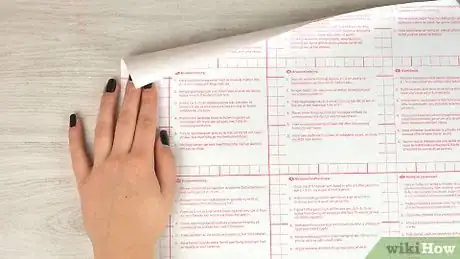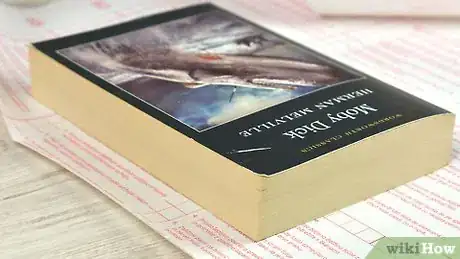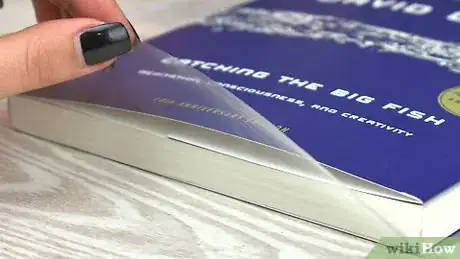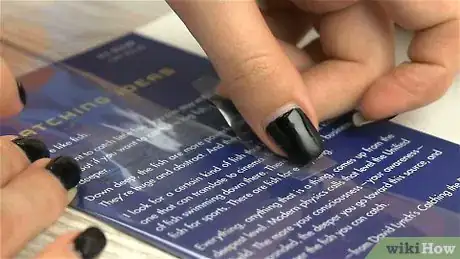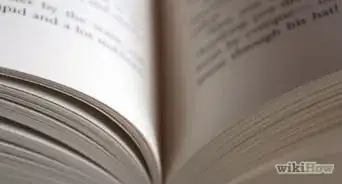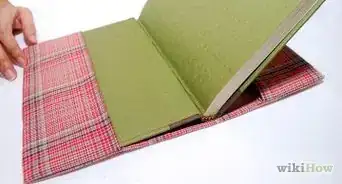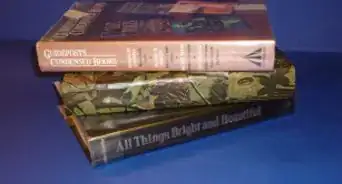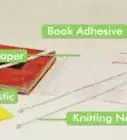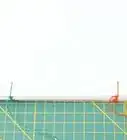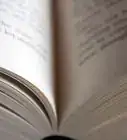This article was co-authored by Lois Wade. Lois Wade was a high school librarian for four years. She is experienced in repairing books, resewing bindings, and protecting books, along with general book care and organization.
There are 15 references cited in this article, which can be found at the bottom of the page.
This article has been viewed 419,931 times.
Covering your paperback books with plastic is a great way to protect them for years to come. There are 2 main materials you can use. Contact paper works like a sticker and adheres to the book. Non-adhesive plastic wrap doesn't stick on its own and needs to be taped down. Both methods will protect your books, so choose the material you prefer working with.
Steps
Sizing Contact Paper
-
1Lay a sheet of contact paper flat on a table with the paper side up. Contact paper comes in rolls. Unroll some and lay it flat on the table. Make sure the paper side is facing up.[1]
- Don’t unroll too much paper at first, or the wrapping will be difficult to work with. You can always unroll a little more later if the book is large.
- Contact paper is available at many convenience stores, as well as arts and crafts stores. You can also order a roll online.
-
2Place the book on the paper with the text block 1 inch (2.5 cm) from the end. The text block is the opposite end from the spine. Arrange this edge parallel with the end of the paper. Leave a 1 inch (2.5 cm) space between the book and the end of the paper so you have room to wrap the plastic over the inside cover.[2]Advertisement
-
3Draw a line along the spine of the book. Take a pencil and trace up the spine of the book. Hold the book down so it doesn’t shift while you draw the line.[3]
- Don’t draw the line from one end of the wrapping to the other. Just make the line as long as the book.
- A pen will also work, but there may be some ink marks on the plastic wrapping.
-
4Flip the book over the line you drew. Imagine the line forms a hinge for the spine to rotate on. Flip the book to the other side of the line so the spine still faces the line. Then arrange the book so it’s parallel with the line.[4]
- You can also slide the book over and align the text block with the line. The position of the book doesn’t matter, as long as you get an accurate measurement.
-
5Cut the paper 2 inches (5.1 cm) from the side of the book. Measure 2 inches (5.1 cm) from the end of the text block. Then use a sharp pair of scissors and cut the sheet of contact paper off the roll.[5]
- This cut doesn’t have to be perfectly straight. Just make sure you leave enough room for the wrapping to fold over the book cover.
Wrapping the Book in Contact Paper
-
1Peel 1 inch (2.5 cm) of paper off the side of the plastic layer. Contact paper works like a band-aid or sticker. Start at one of the side corners and lift the backing paper up, exposing the sticky plastic underneath. Work your way down and peel 1 inch (2.5 cm) of paper off. Then fold the paper over, making a straight line parallel with the plastic.[6]
- Don’t peel off any more than 1 inch (2.5 cm). The contact paper will be very difficult to work with and could stick to itself if you peel all the paper off at once.
- Work from the sides of the contact paper, not the top or bottom. You measured the paper from the sides of the book, so the size will be incorrect if you peel the top or bottom first.
-
2Lay the book’s text block just over the fold so it touches the sticky plastic. Line up the book where the backing paper and contact paper meet. Then press the book cover onto the contact paper. Press your hand down along the book cover to work out any air bubbles under the plastic.[7]
- Make sure the book cover is straight. If it’s crooked, your measurements will be off. Peel the book off and press it down again to straighten it out.
-
3Pull the backing paper off while pressing the contact paper down. With the contact paper sticking onto one side of the book cover, flip the book over so the cover is facing up. Hold the cover down with one hand and grab the fold of backing paper with your other hand. Pull the backing paper slowly to peel it off. At the same time, use your other hand to press the contact paper down onto the book cover.[8]
- Smooth out any bubbles as you press the contact paper down.
- Use a ruler or similar instrument to help press the contact paper down and push out any bubbles.[9]
-
4Cut the corners off the contact paper at a 45-degree angle. Stop peeling when you reach the book spine. Take a scissor and cut diagonally along the corners of the contact paper at a 45-degree angle. Get close to the book cover but be careful not to cut it. Then cut the contact paper at the spine straight down towards the book, parallel with the spine. Get as close to the book as you can without hitting the cover.[10]
- With these cuts, you can easily fold the contact paper inside the book.
-
5Fold the sticky contact paper inside the book cover. Start with the contact paper near the block text. Fold this flap inside the book cover and press it down to work out any bubbles. Then do the same with the 2 side flaps.[11]
- If you make a mistake or leave bubbles under the contact paper, carefully peel up the wrapper and press it down again.
-
6Wrap the contact paper around the spine of the book and cover the other side. With the first side secure, continue working around the book. Press the contact paper down around the book spine and be careful to work out all the air bubbles. Then, continue onto the other side. When you reach the end of the book, peel the excess backing paper off completely.[12]
- Remember to keep working with your hand to squeeze out any air bubbles that get trapped.
-
7Cut the corners off the contact paper on the other side. Use the same technique you did on the first side. Cut diagonally along the contact paper at the book corners, taking care not to cut the cover. Then cut straight down towards the cover on the wrapping near the book spine.[13]
- Just snip off the remaining contact paper around the book spine.
-
8Press the remaining contact paper flaps underneath the book cover. Finish the job by tucking the last bit of contact paper under the book cover. Fold the piece near the block text first. Then fold the 2 flaps. Press all the flaps down to work out any air bubbles.[14]
Using Non-Adhesive Plastic Wrap
-
1Cut the plastic wrapping so it's 4 inches (10 cm) longer than the book cover. Unlike contact paper, plastic wrapping does not have an adhesive backing, so it doesn't stick on its own. Roll a bit out on a flat surface and place the book on it. Lay the book 2 inches (5.1 cm) from the end of the plastic. Then roll the plastic around the rest of the book until it extends 2 inches (5.1 cm) from the other side. Cut along this line.[15]
- Plastic wrapping is available from office supply or craft stores, or online.
-
2Leave 2 inches (5.1 cm) of plastic wrap on the top and bottom of the book. Lay the book in the center of the plastic sheet. Then measure 2 inches (5.1 cm) from the top and bottom. Cut the plastic wrapping at this point so you have enough to wrap the book.[16]
-
3Wrap the plastic on the sides underneath the front and back covers. Press the plastic down so it fits tightly over both covers. Use a small strip of clear tape and secure the plastic to the front cover. This is only supposed to hold the plastic down while you work, so no need to use a lot of tape.[17]
- Don't fold the corners of the plastic down yet. Leave the plastic arranged so 2 inches (5.1 cm) of wrapping are on the top and bottom of the book.
- Only use tape on the front cover. Do not place any tape on the back cover yet.
-
4Cut the plastic at the spine straight down towards the book. Line up your scissors so they're parallel with the book spine. Then snip the plastic on the top and bottom of the book straight down. Get as close to the cover as you can without cutting it. This gives you 2 tabs at the book spine, 1 on the top and 1 on the bottom. Snip both tabs off.[18]
- If your scissors are long enough, you can snip both layers (front and back) of the plastic at the same time. If they aren't then cut each one individually.
-
5Snip the remaining corners off the plastic at 45-degree angles. Again, get as close to the book as you can without cutting the cover. Do this for the 2 corners on the front and back of the book.[19]
-
6Fold the top and bottom flaps under the cover and tape the plastic down. Start on the front cover. Fold the top and bottom flaps down underneath the cover. Then tape the side flaps to the front flap so no tape touches the book cover. Then do the same for the back cover.[20]
- Keeping tape off the cover makes it easier to replace the cover in the future. You can just undo the tape holding the plastic together rather than peeling the tape off the cover. This could damage your book.
Community Q&A
-
QuestionWhat if I want something I can remove when done?
 Community AnswerTry PVC plastic sheets. It's similar to wrapping paper but it's clear plastic.
Community AnswerTry PVC plastic sheets. It's similar to wrapping paper but it's clear plastic. -
QuestionCan you peel it off without damaging the book?
 Community AnswerNo, you generally can't. If you do, anything between the top layer of the cover and the whole cover can rip right off.
Community AnswerNo, you generally can't. If you do, anything between the top layer of the cover and the whole cover can rip right off. -
QuestionCan I laminate the dust jacket onto the book too, so it doesn't remove itself?
 Alia TeeCommunity AnswerI know our public library does this, just make sure you don't leave any air pockets.
Alia TeeCommunity AnswerI know our public library does this, just make sure you don't leave any air pockets.
Warnings
- Do not wrap antique or collectible books. This will ruin their value.⧼thumbs_response⧽
Things You'll Need
- Contact paper
- Non-adhesive plastic wrapping
- Scissors
- Tape
References
- ↑ https://youtu.be/pYOVVuO3vRs?t=22
- ↑ http://preschoolersandpeace.com/blog/2012/6/16/how-to-cover-paperbacks-with-contact-paper.html
- ↑ https://youtu.be/pYOVVuO3vRs?t=22
- ↑ http://preschoolersandpeace.com/blog/2012/6/16/how-to-cover-paperbacks-with-contact-paper.html
- ↑ https://youtu.be/pYOVVuO3vRs?t=34
- ↑ https://youtu.be/pYOVVuO3vRs?t=58
- ↑ https://youtu.be/pYOVVuO3vRs?t=91
- ↑ https://youtu.be/pYOVVuO3vRs?t=119
- ↑ https://www.bhg.com.au/how-to-cover-books-with-contact
- ↑ http://preschoolersandpeace.com/blog/2012/6/16/how-to-cover-paperbacks-with-contact-paper.html
- ↑ https://youtu.be/pYOVVuO3vRs?t=167
- ↑ https://youtu.be/pYOVVuO3vRs?t=254
- ↑ https://youtu.be/pYOVVuO3vRs?t=303
- ↑ http://preschoolersandpeace.com/blog/2012/6/16/how-to-cover-paperbacks-with-contact-paper.html
- ↑ https://youtu.be/jCvD4zDzkJc?t=17
- ↑ https://youtu.be/jCvD4zDzkJc?t=17
- ↑ https://youtu.be/jCvD4zDzkJc?t=34
- ↑ https://youtu.be/jCvD4zDzkJc?t=57
- ↑ https://youtu.be/jCvD4zDzkJc?t=81
- ↑ https://youtu.be/jCvD4zDzkJc?t=181
About This Article
Covering your paperback books with plastic film is a great way to keep them looking new for longer. For an easy approach, place your book on top of some plastic wrap, making sure there’s about 2 inches of wrap extending beyond the top and bottom of the book. You’ll need to fold about 2 inches of the wrap over the inside of the cover on all three sides. Then, tape the top and bottom folds of wrap to the wrap running along the long side of the book so it stays in place without being taped to the original book cover. Cut the plastic wrap straight down the spine of your book, then repeat the entire process to do the back cover. For tips on how to cover your book with contact paper, keep reading!
